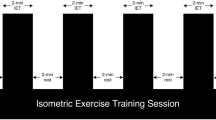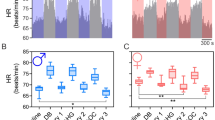Abstract
Purpose
Individuals with Down syndrome (DS) exhibit autonomic dysfunction, manifested as attenuated heart rate (HR) and blood pressure (BP) responses to sympathoexcitation. Whether a subgroup of individuals with DS with a normal HR response would have normal autonomic responses to sympathoexcitation remains unclear.
Methods
We compared autonomic modulation using HR variability (HRV) and BP responses in individuals with and without DS (controls) matched for the HR change to isometric handgrip (HG) (10 DS, 8 controls) and submaximal cycling exercise (CE) (9 DS, 9 controls). HG was performed for 2 min at 30 % of maximal voluntary contraction. CE included two 6-min stages at 0 W and at 50 % of body weight. Beat-to-beat HR and BP were recorded. HRV variables were natural log transformation (Ln) of low frequency (LF), high frequency (HF), LF/HF ratio, total power (TP), and the root mean square of successive differences (RMSSD).
Results
In the HG study, although individuals with DS exhibited an overall lower systolic BP, LF/HF ratio, and LnLF/LnHF, their BP and HRV responses to HG were similar to those of the controls. In the CE study, individuals with DS exhibited lower resting LnLF and an overall lower systolic BP and mean arterial pressure compared with controls. During the CE, individuals with DS exhibited an increased diastolic BP and a smaller reduction in LnTP than controls. These differences disappeared after controlling for confounders.
Conclusions
Our results suggest that despite normal HR responses to sympathoexcitatory tasks, HRV was largely similar to controls, with some evidence of autonomic dysfunction in individuals with DS.
Similar content being viewed by others
References
Agiovlasitis S, Collier SR, Baynard T, Echols GH, Goulopoulou S, Figueroa A, Beets MW, Pitetti KH, Fernhall B (2010) Autonomic response to upright tilt in people with and without Down syndrome. Res Dev Disabil 31:857–863
Baynard T, Pitetti KH, Guerra M, Fernhall B (2004) Heart rate variability at rest and during exercise in persons with Down syndrome. Arch Phys Med Rehabil 85:1285–1290
Baynard T, Pitetti KH, Guerra M, Unnithan VB, Fernhall B (2008) Age-related changes in aerobic capacity in individuals with mental retardation: a 20-yr review. Med Sci Sports Exerc 40:1984–1989
Benditt DG, Ermis C, Padanilam B, Samniah N, Sakaguchi S (2003) Catecholamine response during haemodynamically stable upright posture in individuals with and without tilt-table induced vasovagal syncope. Eur Eur Pacing Arrhythm Card Electrophysiol J Work Groups Card Pacing Arrhythm Card Cell Electrophysiol Eur Soc Cardiol 5:65–70
Bunsawat K, Goulopoulou S, Collier SR, Figueroa A, Pitetti KH, Baynard T (2015) Normal HR with tilt, yet autonomic dysfunction in persons with Down syndrome. Med Sci Sports Exerc 47:250–256
Fernhall B, Baynard T (2013) Down syndrome and exercise testing training. In: Ehrman JK, Gordon PM, Visich PS, Keteyian SJ (eds) Clinical exercise physiology, 3rd edn. Human Kinetics, Champaign, pp 617–631
Fernhall B, Baynard T, Collier SR, Figueroa A, Goulopoulou S, Kamimori GH, Pitetti KH (2009) Catecholamine response to maximal exercise in persons with Down syndrome. Am J Cardiol 103:724–726
Fernhall B, Figueroa A, Collier S, Baynard T, Giannopoulou I, Goulopoulou S (2005) Blunted heart rate response to upright tilt in people with Down syndrome. Arch Phys Med Rehabil 86:813–818
Fernhall B, Mendonca GV, Baynard T (2013) Reduced work capacity in individuals with Down syndrome: a consequence of autonomic dysfunction? Exerc Sport Sci Rev 41:138–147
Fernhall B, Otterstetter M (2003) Attenuated responses to sympathoexcitation in individuals with Down syndrome. J Appl Physiol (1985) 94:2158–2165
Figueroa A, Collier SR, Baynard T, Giannopoulou I, Goulopoulou S, Fernhall B (2005) Impaired vagal modulation of heart rate in individuals with Down syndrome. Clin Auton Res Off J Clin Auton Res Soc 15:45–50
Goldstein DS, Bentho O, Park MY, Sharabi Y (2011) Low-frequency power of heart rate variability is not a measure of cardiac sympathetic tone but may be a measure of modulation of cardiac autonomic outflows by baroreflexes. Exp Physiol 96:1255–1261
Heffernan KS, Baynard T, Goulopoulou S, Giannopoulou I, Collier SR, Figueroa A, Fernhall B (2005) Baroreflex sensitivity during static exercise in individuals with Down syndrome. Med Sci Sports Exerc 37:2026–2031
Iellamo F, Galante A, Legramante JM, Lippi ME, Condoluci C, Albertini G, Volterrani M (2005) Altered autonomic cardiac regulation in individuals with Down syndrome. Am J Physiol Heart Circ Physiol 289:H2387–H2391
Lauer MS (2009) Autonomic function and prognosis. Clevel Clin J Med 76(Suppl 2):S18–S22
Lewis MJ (2005) Heart rate variability analysis: a tool to assess cardiac autonomic function. Comput Inform Nurs CIN 23:335–341
Mendonca GV, Pereira FD, Fernhall B (2010) Reduced exercise capacity in persons with Down syndrome: cause, effect, and management. Ther Clin Risk Manag 6:601–610
Mendonca GV, Pereira FD, Fernhall B (2011) Cardiac autonomic function during submaximal treadmill exercise in adults with Down syndrome. Res Dev Disabil 32:532–539
Mendonca GV, Pereira FD, Fernhall B (2013) Heart rate recovery and variability following combined aerobic and resistance exercise training in adults with and without Down syndrome. Res Dev Disabil 34:353–361
Mir GH, Cumming GR (1971) Response to atropine in Down’s syndrome. Arch Dis Child 46:61–65
Olufsen MS, Alston AV, Tran HT, Ottesen JT, Novak V (2008) Modeling heart rate regulation—part I: sit-to-stand versus head-up tilt. Cardiovasc Eng 8:73–87
Quilliot D, Fluckiger L, Zannad F, Drouin P, Ziegler O (2001) Impaired autonomic control of heart rate and blood pressure in obesity: role of age and of insulin-resistance. Clin Auton Res Off J Clin Auton Res Soc 11:79–86
Sassi R, Cerutti S, Lombardi F, Malik M, Huikuri HV, Peng CK, Schmidt G, Yamamoto Y, Document R, Gorenek B, Lip GY, Grassi G, Kudaiberdieva G, Fisher JP, Zabel M, Macfadyen R (2015) Advances in heart rate variability signal analysis: joint position statement by the e-Cardiology ESC Working Group and the European Heart Rhythm Association co-endorsed by the Asia Pacific Heart Rhythm Society. Eur Eur Pacing Arrhythm Card Electrophysiol J Work Groups Card Pacing Arrhythm Card Cell Electrophysiol Eur Soc Cardiol 17:1341–1353
Task Force (1996) Heart rate variability: standards of measurement, physiological interpretation, and clinical use. Task Force of the European Society of Cardiology and the North American Society of Pacing and Electrophysiology. Eur Heart J 17:354–381
Zahorska-Markiewicz B, Kuagowska E, Kucio C, Klin M (1993) Heart rate variability in obesity. Int J Obes Relat Metab Disord J Int Assoc Study Obes 17:21–23
Acknowledgments
We would like to thank Dr. Bo Fernhall for his insightful comments on this manuscript. The study was partly supported by the American Heart Association.
Author information
Authors and Affiliations
Corresponding author
Electronic supplementary material
Below is the link to the electronic supplementary material.
Rights and permissions
About this article
Cite this article
Bunsawat, K., Baynard, T. Cardiac autonomic modulation and blood pressure responses to isometric handgrip and submaximal cycling exercise in individuals with down syndrome. Clin Auton Res 26, 253–260 (2016). https://doi.org/10.1007/s10286-016-0361-y
Received:
Accepted:
Published:
Issue Date:
DOI: https://doi.org/10.1007/s10286-016-0361-y




